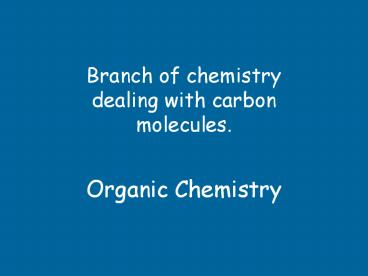Organic Chemistry - PowerPoint PPT Presentation
Title:
Organic Chemistry
Description:
Branch of chemistry dealing with carbon molecules. Organic Chemistry Hydrocarbons Compounds containing only carbon & hydrogen Why can carbon form so many compounds? – PowerPoint PPT presentation
Number of Views:312
Avg rating:3.0/5.0
Title: Organic Chemistry
1
Organic Chemistry
- Branch of chemistry dealing with carbon molecules.
2
Hydrocarbons
- Compounds containing only carbon hydrogen
3
Why can carbon form so many compounds?
- It can form up to 4 covalent bonds with other
carbon atoms.
4
What is the maximum of bonds between any 2 C
atoms?
- A triple bond
- (3 pairs or 6 electrons)
5
Properties of hydrocarbon molecules
- Molecular
- Low melting points
- Low boiling points
- Low Hf
- Low Hv
- High evaporation rate
- High vapor pressure
- May be gases, liquids, or solids
- Decompose on heating
- Poor conductors of heat electricity
- Nonpolar (vdw forces)
- Dissolve in nonpolar solvents
- React slowly
- Solids may be soft or brittle
6
Bonding capacity of H?
- 1
7
Bonding capacity of O?
- 2
8
Bonding capacity of the halogens (F, Cl, Br, I)?
- 1
9
Bonding capacity of S?
- 2
10
Bonding capacity of N P?
- 3
11
Bonding capacity of C?
- 4
12
The 4 single bonds of a carbon atom are directed
to
- the corners of a regular tetrahedron.
13
Saturated hydrocarbon
- Hydrocarbon containing only single carbon-carbon
bonds
14
Unsaturated hydrocarbon
- Hydrocarbon containing at least 1 double or
triple carbon-carbon bond
15
Chemical or Molecular Formulas
- Tell the kind number of atoms in a molecule.
16
Structural Formulas
- Tell the kind number of atoms in a molecule.
Also attempt to show approximate shapes bonding
patterns of molecules.
17
Homologous Series
- A group of related compounds in which each member
differs from the one before it by the same
additional unit. Properties vary in a
predictable way.
18
Alkanes
- Homologous series of saturated hydrocarbons. with
the general formula CnH2n2. - Ratio of C to H is n2n2
19
Alkanes
- Release energy when burned fuels.
20
Naming Alkanes
- Prefix depends on of carbon atoms in longest
continuous chain. - Suffix ane
21
Properties of Alkanes
- Nonpolar.
- Boiling point ? as of carbon atoms ?. (van der
Waals forces increase with size). - Insoluble in water. (Like dissolves like.)
22
Nonpolar
- The electron cloud of the molecule is fairly
evenly distributed. Either - Molecule has atoms with similar
electronegativities - Molecule has high symmetry
23
Isomers
- Molecules with the same chemical formula but
different structural formulas. - Different chemical physical properties.
Different names. - Same formula mass percentage composition.
24
Isomers
- of possible isomers ? as of C atoms ?
25
Alkenes
- Homologous series of unsaturated hydrocarbons
containing 1 double carbon-carbon bond.
26
General formula of alkenes
- CnH2n
27
Naming Alkenes
- Prefix depends on of carbon atoms in longest
continuous chain. - Suffix ene
- in front may give location of double bond.
28
Properties of Alkenes
- Slightly more reactive than the alkanes. Double
bond is site of reactivity.
29
Alkynes
- Homologous series of unsaturated hydrocarbons
containing 1 carbon-carbon triple bond.
30
General formula of alkynes
- CnH2n-2
31
Naming alkynes
- Prefix depends on of carbon atoms in longest
continuous chain. - Suffix yne
- in front gives location of triple bond.































